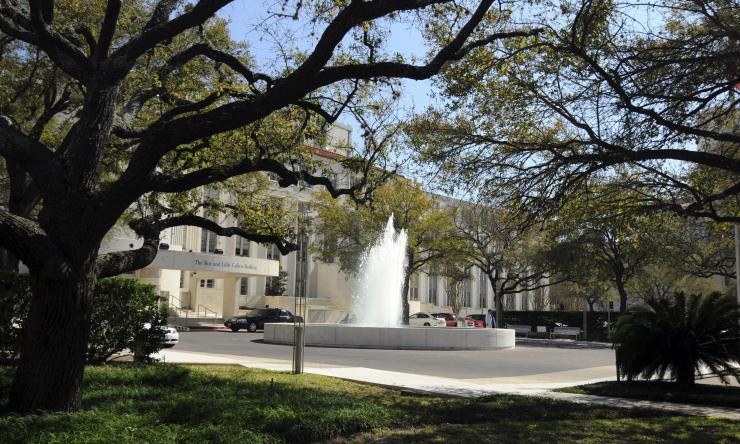Center for NextGen Therapeutics helps match researchers to molecules
Dr. Jin Wang, Michael E. DeBakey, M.D., Endowed Professor in Pharmacology and director of the new Center for NextGen Therapeutics at Baylor College of Medicine explains what this center has to offer for researchers not just at Baylor College of Medicine, but across the Texas Medical Center and beyond.
What is the Center for NextGen Therapeutics?
The Center for Nextgen Therapeutics (CNGT) primarily focuses on developing multispecific drugs by leveraging the cutting edge biological and biomedical research at Baylor College of Medicine.
What is the goal of the center?
Our mission is to accelerate the discovery and development of novel therapeutics that address unmet medical needs and improve patient outcomes.
What need is this Center fulfilling?
Many biologists and physician-scientists have deep knowledge of diseases and targets but lack the resources to commit to a drug discovery screening. This new center will fill the gap by shouldering the upfront cost for target-agnostic screens and matchmaking with the disease-focused scientists.
For many biologists, they will first find the target and then do screenings to find the most effective way to attack the target. However, this target-based drug discovery strategy requires significant upfront commitment of resources.
Our strategy is molecule oriented, similar to the concept of phenotypic screen. By leveraging state-of-the-art proteomics technologies, we conduct comprehensive, target-agnostic screens across the entire proteome to identify a curated list of proteins that demonstrate potential for small molecule targeting. With that information, we have created a library of molecules.
For example, we screen many molecules, even thousands of molecules, and we can get a list of proteins that are affected by these molecules. Biologists will look at the list to see whether their favorite target is there, and we can provide the particular molecule they need.
We are basically the matchmakers for researchers and the relevant compound. Once researchers validate the efficacy of the compound, our center offers the opportunity for collaborative co-development of the compound series, focusing on optimizing its drug-like properties.
What is your research focus? How did that lead to the creation of this Center?
My background is in chemistry and my research primarily focuses on drug discovery, including small molecule inhibitors, targeted protein degraders and antibody drug conjugates.
For example, my early work involved developing SRC 3 inhibitors in collaboration with Dr. Bert O’Malley. That was actually my group’s first drug discovery project here at Baylor. Later, I also worked with Dr. Hui Zheng in the Huffington Center on Aging on a small model inhibitor project that could be used to treat Alzheimer's disease.
In 2016, I started working on these so-called targeted protein degraders. What that means is, generally for small molecule inhibitors you bind to the pocket of the enzyme to block the enzyme function. But the protein molecule itself is still there and could still trigger certain signaling pathways through its so-called scaffolding functions. So, if we degrade the protein or get rid of the protein completely in cells, this addresses both the enzyme-dependent and independent functions of the protein.
This is the technology that led to the creation of the center. I want to expand this technology at Baylor so other researchers can leverage our knowledge and develop degraders for other targets.
We also work on antibody drug conjugates, putting a highly potent toxin or any other potent compound, such as degraders, onto an antibody to try to deliver that into a specific tissue or tumor.
How is the Center for NextGen Therapeutics working with the Center for Drug Discovery?
Biological and biomedical studies lead to new targets to treat diseases. To develop therapeutics against the target of interest, one can either develop new molecules against the specific target or use existing known molecules against this target.
The Center for Drug Discovery applies DNA-encoded libraries to screen against targets of interest. This usually requires purified target proteins and some upfront committed resources to carry out the screening. Our center uses the “molecule-first” strategy for drug discovery. These strategies are complementary to each other, and we look forward to seeing how these different approaches can support our common goals.
Can you describe transformative waves of biopharmaceutical industry? How did that help to shape the center?
Defined by Dr. Raymond Deshaies, senior vice president at Amgen, these different waves all revolve around drug discovery with the goal of being able to treat most or all diseases. The industry is focused on using different strategies to find the best way to deliver the most effective treatment. Right now, we are on what Dr. Deshaies describes as the fourth wave, which is focused on multispecific drugs that engage two or more entities simultaneously, including antibody drug conjugates and molecular matchmakers. We are focused on this strategy to support the unmet needs in the healthcare industry.
The others “transformative waves” include:
- The first wave (around 1900) is marked by the introduction of aspirin; this wave combined chemistry and pharmacology to yield defined therapeutic molecules.
- The second wave (1970s) introduced target-centric rational drug discovery, focusing on identifying molecules that could bind to specific disease targets.
- The third wave (early 1980s) brought recombinant proteins and monoclonal antibodies, such as Humulin and Muromonab, which became some of the biggest-selling drugs.











